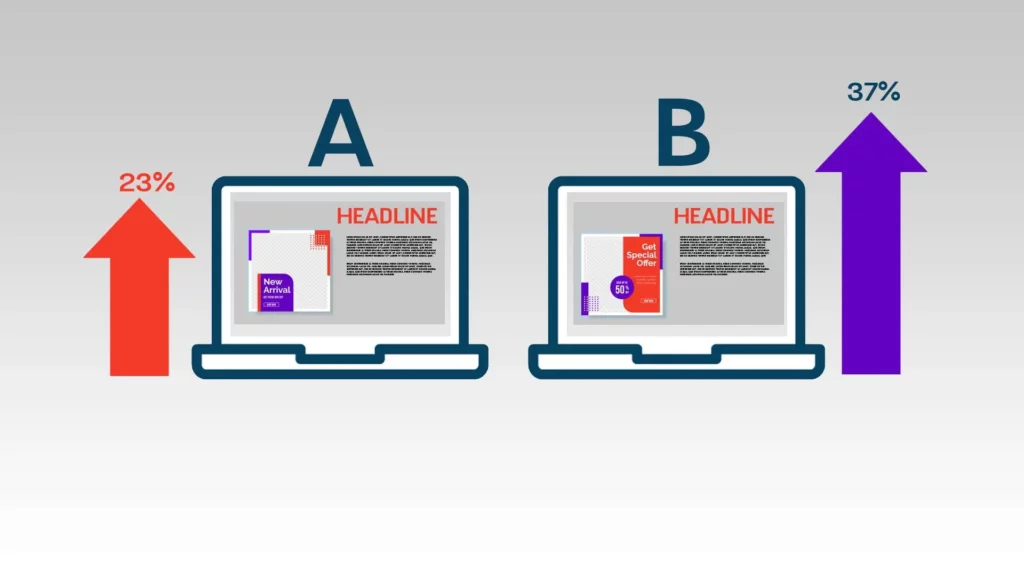Continuous testing is a crucial factor in achieving success in email marketing as it allows you to identify effective strategies and enhance your email campaigns.
There will be instances when your email recipients respond more favorably to certain elements such as design, subject lines, call-to-action, and more, even if it contradicts your initial assumptions. This is why it’s important to regularly conduct A/B tests, enabling you to make informed decisions based on evidence and improve the performance of your campaigns.
If you haven’t conducted any A/B tests before, you might be unsure about the process, its benefits, and what aspects you should test. The good news is that A/B testing is a straightforward method of experimentation.
What is A/B Testing?
Split testing, also referred to as A/B testing, is a straightforward technique that involves sending two different variants (A and B) to your email list and analyzing their performance to determine the better-performing variant.

The variations between the two could be subtle, such as using different wording in the subject line, which might go unnoticed by most subscribers. Alternatively, the differences could be more significant, such as employing a completely different email design and layout.
To ensure reliable results, it is important to test only one element at a time during A/B testing. This approach allows you to attribute any performance differences between the variants to that specific element, rather than relying on gut feelings to determine the contributing factors.
When evaluating the performance, there are several email metrics that you should consider:
- Open Rates
- Click Rates
- Conversion Rates
What Are The Benefits of A/B Testing?

Applying consistent A/B testing will lead to gradual improvements in your important email marketing metrics. These metrics consist of:
1. Improved Open Rates
By conducting tests on the various elements that impact your open rate, such as subject lines and preview text, you can gain valuable insights into what captures the attention of your subscribers and what doesn’t. This knowledge will allow you to strengthen your future campaigns to generate a higher number of email opens.
2. Improved Click Through Rates
Similar to how you analyze your open rates, conducting tests on various components within your email will gradually provide you with valuable insights into the kind of content and links that attract clicks from your subscribers. Armed with this knowledge, you can optimize your future emails by focusing on what you have discovered to be effective, thus enhancing your click-through rate.
3. Improved Conversion Rates
By enhancing both your open and click through rates, you will effectively increase the number of prospective customers visiting your website. Consequently, this will lead to a higher volume of sales, particularly if you incorporate A/B testing for elements on your online store, ultimately resulting in an enhanced conversion rate.
What Can You A/B Test?

When it comes to email marketing, there are many possibilities for A/B testing. While several ideas may come to mind initially, there is a wide range of potential tests you can conduct. Some examples include:
1. Preview Text
The preview text is an optional line of text that comes before your subject line. Its purpose is similar to that of the subject line, and it can be effectively tested using A/B testing methods. Just as you would evaluate different versions of subject lines, the primary metric to monitor when conducting experiments with preview text is your open rate.
2. Subject Line
Testing subject lines is a popular practice among email marketers as they offer flexibility and many marketers already have potential subject line ideas in mind. When you’ve chosen the two subject lines to test and sent out the email, it’s crucial to monitor the open rate as the primary metric.
While it’s important to also consider click and conversion rates, the subject line is one of the few elements subscribers encounter before opening an email. Therefore, the open rate is the metric most affected by subject line experimentation. Once the email is opened, the email design and content play a more significant role in influencing whether recipients click through to the website and make a purchase or not.
3. Sender Name
The sender name is the identity displayed to your subscribers when they see your email in their inbox. Typically, it is the brand name alone, however, certain brands inject personality into their sender name by incorporating the name of an individual, like their founder.
Consider exploring this approach in your upcoming email campaigns. If you choose to conduct an A/B test of this nature, the open rate becomes a crucial metric to monitor.
4. What Time to Send Your Emails
Many marketers have a routine of sending their campaigns at the same time and day each week. The timing of your email sends can significantly influence your open rate.
To determine the optimal day for sending emails to your customers, conducting A/B tests is crucial. Vary the day of the week, such as comparing Monday and Wednesday, and also experiment with different times of the day, like morning versus afternoon.
Once again, the primary metric to focus on in these tests is your open rate. Analyzing this data will provide valuable insights into the most effective timing for engaging your audience.
5. Your Call To Action
The call-to-action (CTA) plays a crucial role in your email by motivating subscribers to take specific actions, such as clicking to explore a product collection or redeeming an offer. Given its significance, it is highly valuable to experiment with different variations of CTA wording. For instance, compare phrases like “Shop now and enjoy 50% off!” or “Claim your exclusive offer today!”
Since CTAs typically direct recipients to click through to a specific page, the primary metric that will be affected by these variations is your click-through rate. Monitoring and analyzing this metric will provide insights into the effectiveness of different CTA approaches in driving engagement.
6. Email Design
Designing an effective email involves considering various factors, including the layout, number of columns, image style, and the decision of whether to include images or not.
It is important to avoid altering too many elements simultaneously during a single A/B test, as it can make it difficult to pinpoint which specific change influenced the results. However, conducting experiments to refine your email design is worthwhile.
7. Email Length
Sellers often have different preferences when it comes to email length. Some prefer lengthy emails that showcase a wide range of products, while others opt for shorter, concise emails.
Regardless of your approach, it can be valuable to experiment with varying email lengths to gauge your subscribers’ response. By sending emails that are either longer or shorter than your usual content, you can observe the impact it has on your click rate. Analyzing this data will provide insights into the optimal email length for engaging your audience effectively.
Wrap Up
A/B testing is a powerful tool for email marketers that allows them to optimize their campaigns and achieve better results. By testing different elements such as subject lines, email content, visuals, call-to-action buttons, and sending times, marketers can gain valuable insights into what resonates best with their audience.
A/B testing provides a data-driven approach to decision-making, helping marketers understand the preferences and behaviors of their subscribers. Through systematic testing, they can identify the most effective strategies to improve open rates, click-through rates, conversions, and ultimately, their overall email marketing performance.
However, it’s important to approach A/B testing with a clear plan and a solid understanding of the metrics that matter most to your goals. Randomly testing multiple variables without a structured framework can lead to inconclusive results or even misleading insights.




What is A/B Testing in Email Marketing?